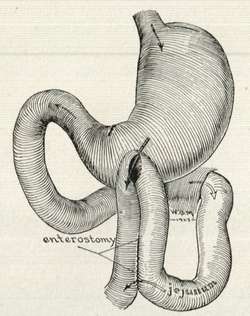
This is a Greek compound word. [ana-] meaning "through or complete", the root term [-stom-] from [stoma], meaning "mouth or opening" and the suffix [-osis] meaning "condition". Usually [-osis] refers to a disease, but in this case it refers to an action or process. The plural form for [anastomosis] is [anastomoses].
The word [anastomosis] then refers to the "process or action of creating a complete opening". In reality an anastomosis is the process of creating a permanent opening between two structures which allows for drainage or flow from one structure into the other. The suffix [-ostomy], being the term for "drainage" is the best suffix to describe an anastomosis. An anastomosis can be the result of a surgical procedure or found as a natural occurrence, such as the anastomoses found in the arterial circle of Willis or an abnormal fistula.
The accompanying image shows an early 1900's depiction of an anterior gastrojejunostomy. The term [gastrojejunostomy] is then the "creation of a drainage opening (a common mouth or opening) between the stomach and the jejunum, the second portion of the small intestine.
It is our belief and core competency, that surgical medical device sales representatives and managers should be completely familiar with this medical term, as well as the many types of anastomoses that can be performed surgically. To this end, we have developed a video on the History of Surgical Stapling. At the end of a video you can see a demonstration of the use of these devices to create an anastomosis



